
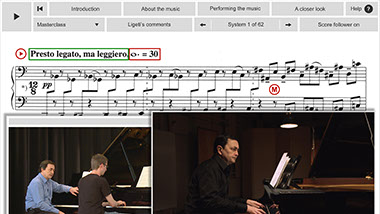 Screenshot of the interactive scoreInteractive scores for Ligeti’s piano works
Screenshot of the interactive scoreInteractive scores for Ligeti’s piano works
The piano occupies a central place in György Ligeti’s oeuvre. It was with the piano collection Musica ricercata that the Hungarian composer laid the foundations of an individual musical language in the early 1950s. In the period from 1985 to 2001 he went on to compose 18 highly virtuosic piano études, which, as well as representing a compendium of the composer’s later work, are among the finest études composed in the twentieth century.
On the following pages, Pierre-Laurent Aimard will take you through selected études and pieces from Musica ricercata. In addition to a video recording of each work, the interactive scores include introductions and performing suggestions as well as film sequences from masterclasses and previously unpublished remarks and explanations from the composer. The online score is based on the edition of Ligeti’s works published by ![]() Schott Music.
Schott Music.
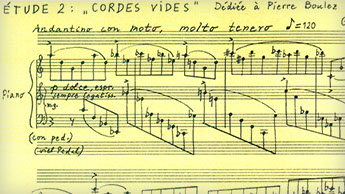
Étude 2: Cordes à vide
Chopin, Liszt, Debussy and others composed piano etudes that concentrated on specific intervals (e.g. octaves, thirds or sixths). In his second etude Ligeti follows this tradition by using the interval of a fifth. The title “Cordes à vide” alludes to the open strings of the violin.
LAUNCH INTERACTIVE SCORE >
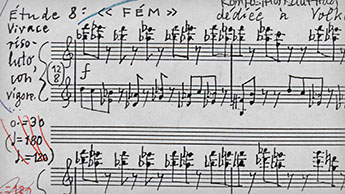
Étude 8: Fém
György Ligeti admired music from Africa. His eighth Piano Étude “Fém” shows this admiration. It also demonstrates the composers interest in American minimal music.
LAUNCH INTERACTIVE SCORE >
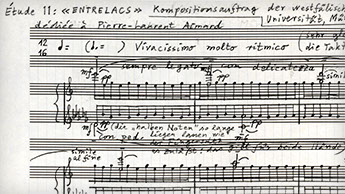
Étude 12: Entrelacs
Ligeti composed the twelfth piano etude “Entrelacs” especially for Pierre-Laurent Aimard. It demands not only the greatest possible hand control but also an infallible sense of tone colour as well as extraordinary powers of perception. With ten fingers, the pianist plays up to seven different layers, each with its own tempo, dynamics and tone colour.
LAUNCH INTERACTIVE SCORE >
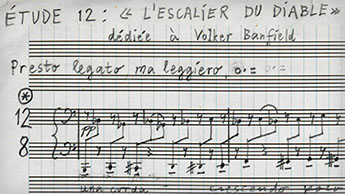
Étude 13: L’escalier du diable
In his Étude 13, György Ligeti expressed in music the idea of a relentless yet futile effort. The title of the work, L’escalier du diable (“The Devil’s Staircase”) alludes both to the endless staircases of the Dutch graphic artist Maurits Escher and to the mathematical function known as the ‘devil’s staircase’.
LAUNCH INTERACTIVE SCORE >
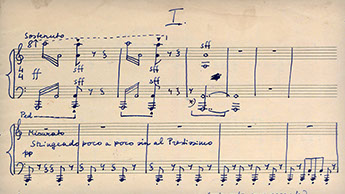
Musica ricercata No. 1
The opening piece of Musica ricercata shows in a very palpable way the creative forces that a radical self-limitation can unleash. Here the composer restricts his musical material – with the exception of the final bars – to a single note: A.
LAUNCH INTERACTIVE SCORE >
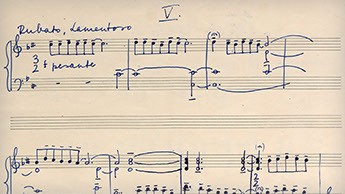
Musica ricercata No. 5
Musical ricercata No. 5 is an instrumental lament inspired by Eastern European mourning rituals that were familiar to the young Ligeti.
LAUNCH INTERACTIVE SCORE >
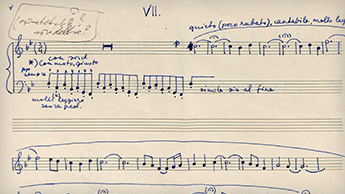
Musica ricercata No. 7
All his life, György Ligeti was fascinated by the idea of creating imaginary musical spaces by compositional means. The seventh piece of Musica ricercata marks his first systematic attempt in this field. Here, each of the pianist's hands seems to be moving in a different space.
LAUNCH INTERACTIVE SCORE >

Inside the score
Musica ricercata No. 1
Étude 8: Fém
Musica ricercata No. 7
Musica ricercata No. 5
Étude 13:
L’escalier du diable
Étude 12:
Entrelacs
Étude 2:
Cordes à vide
Education projects
Performing Ligeti
Inside the score
Credits
Thanks to our partners and sponsors:


